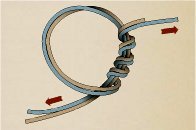HUNTING NEWS CATEGORIES
© 2010 Backcountry Press Outdoor News - All Rights Reserved Website Design by:
 | ||||
KNOTS
There are a large variety of knots for the outdoors including hunting, fishing or boating and each knot has specific properties and suitability for a range of tasks. Some knots are well-adapted to attach to particular objects such as another rope, cleat, ring, or stake. Other knots are made to bind or constrict around an object. Choosing the correct knot for the job at hand is one of the most fundamental aspects of using knots well.
 | ||||
Line Joining Knots
Tying line to line is critical. And when it's called for (for example, when you have a killer rig on 15-pound test line and you want to attach it to the 20-pound test line on your reel without having to retie the whole rig) you need a really good knot. These knots are tested and reliable for joining two pieces of fishing line.
Surgeon's Knot
The surgeon's knot is a simple modification to the reef knot. It adds an extra twist when tying the first throw, forming a Double overhand knot, thus adding friction which makes the knot more secure.
This knot is named for the fact that it is commonly used by surgeons in situations where it is important to maintain tension on a suture. Surgeon's knots are used in fly fishing as well as in tying quilts.
This knot makes it easy to join two lines, but one line must be short, since you have to bring the one end through the formed overhand loop. As with other lines, use a lot of overlapping line so that you can pull on all four ends to make it properly tight. Work with both lines together as you tie this, and make sure both loops are the same size to assure a strong knot.
The Surgeon’s Knot, also known as the Double Surgeon’s Knot, ranks as one of the best and easiest knots to tie for joining lines of equal or unequal diameters. It is simply two overhand knots with the entire leader pulled through the knot each time. It must be tightened by pulling on all four strands to properly seat the knot.
4 Easy Steps for Tying the Surgeon’s Knot:
- Place leader line next to the main line
- Form an overhand knot by passing the long end of the leader and tag end of mainline through the loop
- Form a second over-hand knot by passing the same ends through the loop
- Moisten and tighten by pulling all four ends slowly. Trim tags.










